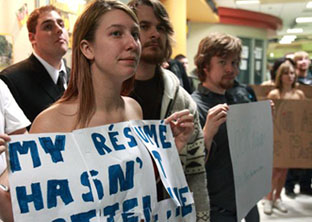Why no one in Calgary today is taking off clothes for a provincially equal Senate
Feb 5th, 2010 | By Counterweights Editors | Category: In Brief
Accounting student Chelsea Bokor, right, and Marketing student Ashley Dinh wear barely the clothes on their backs as they listen to University of Calgary Provost Alan Harrison defend the recent tuition increase announcements at the MacEwan Student Centre February 2. Photograph by: Ted Rhodes, Calgary Herald.
More than 60 years ago Harold Innis, the almost-great Canadian historian (or economist, or economic historian, or communications theorist who inspired Marshall McLuhan, etc, etc), lamented the “futility of political discussion in Canada.” And it is sobering to think that in this respect at least not much has changed since the late 1940s.
Take, for instance, the current debate on Canadian Senate reform, which has been going on for more than a quarter of a century. By now it ought to have made clear that a reformed Senate with an equal number of seats for each province – on the model of such other geographically vast federal systems as the United States and Australia – will not finally work in Canada.
Yet on February 2, 2010 we have the Telegraph-Journal in New Brunswick urging that the “more widespread Senate reform” some still see as latent in Stephen Harper’s latest batch of unelected appointments to the still unreformed Senate of Canada must ultimately include “an equal number of seats” for such places as “Ontario, Alberta and British Columbia” and New Brunswick (to say nothing of Saskatchewan, Manitoba, Nova Scotia, Newfoundland and Labrador, and Prince Edward Island).
The hard political fact of life is that the modern Canadian federation is not quite like either the United States or Australia. A reformed Canadian Senate that better represents provincial interests in federal institutions may remain an important goal (and we believe it is indeed ourselves). But in Canada this goal cannot be achieved by anything quite like equal numbers of Senate seats for each province, regardless of the size or composition of provincial populations.
To start with, the federal systems of the United States and Australia do not include anything like the Canadian province of Quebec. As the Canadian federal Parliament has now recognized, the Quebecois are a nation within a united Canada, and all that. In the end this has to mean Quebec is, whatever else, not a province quite like the others. Any realistic proposal for Canadian Senate reform must somehow recognize this deeply rooted fact of Canadian political life. (And one might even think that a newspaper in New Brunswick – Canada’s only officially bilingual province – would be more sensitive to this fact of life than other parts of the country.)
As a practical matter, the problem doesn’t end with Quebec either. A provincially equal Senate would give a majority of seats to the six least populous Canadian provinces (including New Brunswick), which taken together account for less than 14% of the total Canada-wide population. A reformed Senate which was also “elected” and “effective” as well as “equal” (on the old so-called Alberta “Triple E” model) could wind up giving less than 14% of the Canada-wide democracy (“one person one vote” and all that) at least some decisive control over the lives of the remaining more than 86% of the Canadian people!
It is true enough that even in the United States today the 26 least populous “equal” states which constitute a majority in the Senate at Washington account for only somewhat more than 17% of the total US population. But this is a less obvious practical political problem in a federal system of 50 states than it would be in one of 10 provinces. In the more comparable case of Australia – a federal system of only six states – the four least populous equal states which constitute a majority in the Australian Senate account for some 40% of the total Australian population.

Madi Wozny comes to the forum with barely the clothes on her back as University of Calgary Provost Alan Harrison drew of crowd of hundreds to address students in council chambers as well as in a simulcast in the MacEwan Student Centre on tuition increases February 2. She is a Music Education student. Photograph by: Ted Rhodes, Calgary Herald.
You can of course say that this is just a lot of abstract theorizing, in the selfish interests of people who live in what the Telegraph-Journal calls the “larger powerhouses” of the Canadian federation today. But it does have at least one decisive practical implication for, e.g., the provincial interests of the Alberta where the concept of the Triple E Senate first arose in the 1980s. And there is some evidence that this implication is starting to sink in – in Alberta itself (and even in the neighbouring newly resource-dynamic provincial economy of Saskatchewan).
Not to put too fine a point on the argument, the greatest unintended consequence of a provincially equal reformed Senate in Canada could be a plot by the “small” provinces of the federation – representing increasingly much, much less than a majority of the Canada-wide democracy – to divide up the oil and gas resource revenues of Alberta in the interests of “have-not” Canada, in a way that would make the ill-fated National Energy Policy of the early 1980s look like child’s play. And this may be yet another reason why it’s the cause of lower university tuition fees that has recently prompted the youth of Calgary to take off their clothes at public demonstrations – and not the once grand old cause of Bert Brown’s Triple E Senate!

